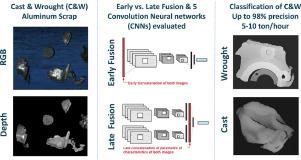Resources, Conservation and Recycling ( IF 11.2 ) Pub Date : 2021-05-28 , DOI: 10.1016/j.resconrec.2021.105685 Dillam Díaz-Romero , Wouter Sterkens , Simon Van den Eynde , Toon Goedemé , Wim Dewulf , Jef Peeters

|
In consequence of the electrification and the increased adoption of lightweight structures in the automotive industry, global demand for wrought Aluminum (Al) is expected to rise while demand for cast Al will stagnate. Since cast alloys can only be converted to wrought alloys by energy-intensive processes, the most promising strategy to avoid the emergence of excess Al cast alloys scrap is to sort cast from wrought alloys. To date, the separation of complex mixes of non-ferrous metals often implies the use of either or both sink-float techniques and/or X-ray fluorescence (XRF) based sorting. Therefore, the presented research develops an efficient method to classify cast and wrought (C&W) alloys in a real-time system with a conveyor belt using transfer learning methods, such as fine-tuning and feature extraction. Five CNNs are evaluated to classify C&W alloys using colour and depth images and transfer learning methods. In addition, the early fusion and late fusion of colour and depth images of C&W Al are investigated. For early fusion, data is added as an extra input channel to the first convolution layer of the CNN, and for later fusion, the images are fed in two separate subnetworks with the same architecture, where the parameters of the fully-connected layers are concatenated in both subnetworks. Our approach shows that late fusion CNN DenseNet allows obtaining the best performances and can achieve up to 98% accuracy.
中文翻译:

用于分离铸铝和锻铝废料的深度学习计算机视觉
由于汽车工业的电气化和轻量化结构的广泛采用,预计全球对锻造铝(Al)的需求将上升,而对铸造铝(Al)的需求将停滞不前。由于铸造合金只能通过能源密集型工艺转化为锻造合金,因此避免出现过量铝铸造合金废料的最有希望的策略是从锻造合金中挑选出铸件。迄今为止,有色金属复杂混合物的分离通常意味着使用沉浮技术和/或基于 X 射线荧光 (XRF) 的分选技术中的一种或两种。因此,本研究开发了一种有效的方法,使用转移学习方法(例如微调和特征提取)在带有传送带的实时系统中对铸造和锻造 (C&W) 合金进行分类。对五个CNN进行了评估,以使用彩色和深度图像以及转移学习方法对C&W合金进行分类。此外,研究了C&W Al的颜色和深度图像的早期融合和晚期融合。对于早期融合,将数据作为额外输入通道添加到 CNN 的第一个卷积层,对于后期融合,图像被馈送到具有相同架构的两个独立子网络中,其中全连接层的参数连接在一起在两个子网中。我们的方法表明后期融合 CNN DenseNet 可以获得最佳性能,并且可以达到高达 98% 的准确率。数据作为额外的输入通道添加到 CNN 的第一个卷积层,为了以后的融合,图像被馈送到具有相同架构的两个独立子网络中,其中全连接层的参数在两个子网络中连接。我们的方法表明后期融合 CNN DenseNet 可以获得最佳性能,并且可以达到高达 98% 的准确率。数据作为额外的输入通道添加到 CNN 的第一个卷积层,为了以后的融合,图像被馈送到具有相同架构的两个独立子网络中,其中全连接层的参数在两个子网络中连接。我们的方法表明后期融合 CNN DenseNet 可以获得最佳性能,并且可以达到高达 98% 的准确率。











































 京公网安备 11010802027423号
京公网安备 11010802027423号